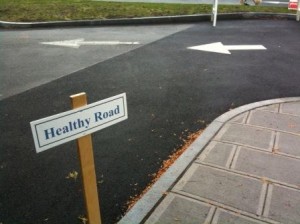Tuesday
Community ArticlesThe Fullness of Full-Catastrophe Living
By Paulette Graf
In the 1970’s I lived with my husband at the Cambridge Zen Center where we became friends with Jon Kabat-Zinn. Jon was active at the Zen Center although he lived in his in his own home with his wife and first-born child. Jon was the only one in the group who had become thus domesticated, and he’d often joke with us quoting Zorba the Greek who had responded to the Englishman’s discovery that Zorba had once been a family man with the statement: “Oh yes, the full catastrophe.” Little did we know that a few years later that would become the title of Jon’s landmark book on Mindfulness-Based Stress Reduction, Full Catastrophe Living. We had been through a lot to deserve that title such as assassinations of JFK, RFK and MLK, civil rights, the “sixties,” Vietnam, Watergate, a recession, The situation seems to have escalated now that 9/11 has come and gone leaving the world in a new atmosphere of threat followed by a broadening economic recession with high unemployment, and wars in Iraq and Afganistan to name a few in a myriad of possibilities for stress.
Before Jon Kabat-Zinn “stress” and “mindfulness” were completely separate words. Stress is a buzzword into today’s society. Whenever I tell someone that I teach MBSR he or she says, “I sure could use that!” Jon’s Mindfulness-Based Stress Program provides a venue through which mindfulness itself is understood to reduce stress, and becomes the tool toward that end.
Editor’s Note: We are currently on hiatus from publishing new articles; in the meantime, please enjoy this classic item reprinted from our back issues.
During those Cambridge days Jon, a dedicated yoga teacher, got his doctorate at MIT while meditating and practicing martial arts. Ultimately he created a unique synthesis of these other methods such as the “body scan” designed to bridge the gap, created by perceived stress, between body and mind.
The approach was put to the test at the U Mass Medical Center to benefit people with various kinds of chronic pain. The participants came to the program out of the kind of desperation that made for genuine commitment, and many saw extraordinary transformation in their relationship to pain. The word got out, the program was aired on PBS’s “Healing and the Mind” series with Bill Moyers. A number of books have been published by Jon: Full Catastrophe Living, Wherever You Go There You Are, Coming to Our Senses, and The Mindful Way through Depression which is a collaboration with him and cognitive therapists Mark Williams, John Teasdale, Zindel Segal.
Originally I loved that MBSR is a way impacting people who might not be apt to set foot in a meditation center. I have taught onsite to hospital staff and in settings like the Salvation Army. When I began teaching One-Evening Workshops and 8-Week Programs at the Shambhala Center of New York I discovered that there were lots of people willing to seek out MBSR in such a setting. Ultimately numerous practitioners from the Shambhala Center have taken the classes. The questions is how would practitioners benefit since they are already meditation?
The answer is that many practitioners tend to compartmentalize their meditation practice from the rest of their lives. Eating is an example. The first MBSR class always begins with the raisin exercise. Raisins are given out to each participant, but they are simply referred to as “objects” to help observe them objectively with fresh eyes. Instead of chomping them down, time is taken to experience taste and texture directly in the present moment as it becomes an exercise in mindfulness. It is a revelation. People really get it because the experience is so fresh, immediate, and direct. They understand that most of the time they eat without much awareness. The experience invites the participants to reapproach their lives. This exercise becomes a model for exploring into our daily activities, cultivating mindfulness throughout the 8-week program and thereafter.
Why does that reduce stress? Say you are struck by the beauty of a brilliant flower. If you stay with the experience you are able to appreciate the “exquisite vividness of the moment”, as Jon Kabat-Zinn describes mindfulness. However, if the sight of the flower immediately reminds you of the garden you tended ten years before when life was different, all the associations with that past experience may arise. They may bring sadness and longing. If you succumb to these emotions stress prevails, and even opens the door to depression. The antidote is the mindfulness that brings that particular flower back into the present moment, an intimate immediacy. Mindfulness empowers our perception of the present moment, and from that we gain strength. The strength to sit beside a dying parent or sick friend or be fully present at the moment of giving birth to a newborn child. Or simply to take a few minutes, step back, pause, and take a breath giving any hectic situation that arises some space.
In addition to the raisin exercise, the MBSR is launched by sitting meditation with the breath as the object in relating to the thinking body. This is the primary model throughout. And it is followed by a guided meditation called the Body Scan. This
Take the Body Scan for example. This meditation is usually done lying down as we focus on the body parts from the toes all the way to the top of the head letting go of each part before going to the next, and finally sweeping thru the entirety of the body from head to toe – essentially unifying all the parts back to the whole. This is a powerful tool that works on many levels along with yoga, movement, and communication methods.
Nancy was in my last program, and was already a Shambhala practitioner. She took the 8-week program due to issues with serious chronic pain. At first she hated the Body Scan, but in her determination she began doing it early in the mornings. (Participants are given CD’s of the Body Scan to take home and follow.) She now loves it, and does it daily as it has impacted her relationship to the pain. Recently Nancy attended her dying grandmother through her last days, and upon return to her home in Brooklyn, experienced a severe flare of her Rheumatoid arthritis and says, “I’m so grateful to have my new mindfulness tools/skills to use now – it helped a great deal through my grandma’s transition – and now dealing with my own illness. Thank you!”
It is through the intimacy of mindfulness that the fullness of catastrophe living extends beyond conflict and disaster to the intricacies of our own humanity. Being human becomes knowable through each unique experience. People of all ages come to MBSR driven by everything from illness, to preparing to take the bar exam, to dealing with the anxieties of job hunting or being the caretakers of others. And it all happens in the safe container of the group where encouragement, discussion, and connection take place. MBSR is a practical path empowering each activity – or even the act of pausing – that invites ultimate contentment.








Mar 6, 2010
Reply
Lovely examples and descriptions. I feel more mindful even after having only read this!
Feb 19, 2010
Reply
We should be trained in the world scan too… just to see how close to extinction the human race and life on our planet is each day…
Jan 30, 2010
Reply
Love it Paulette! xo, G